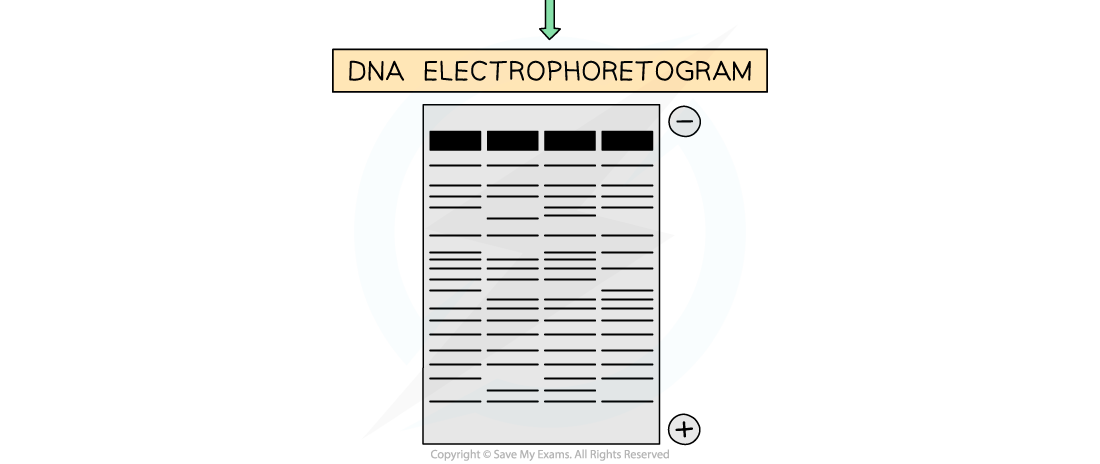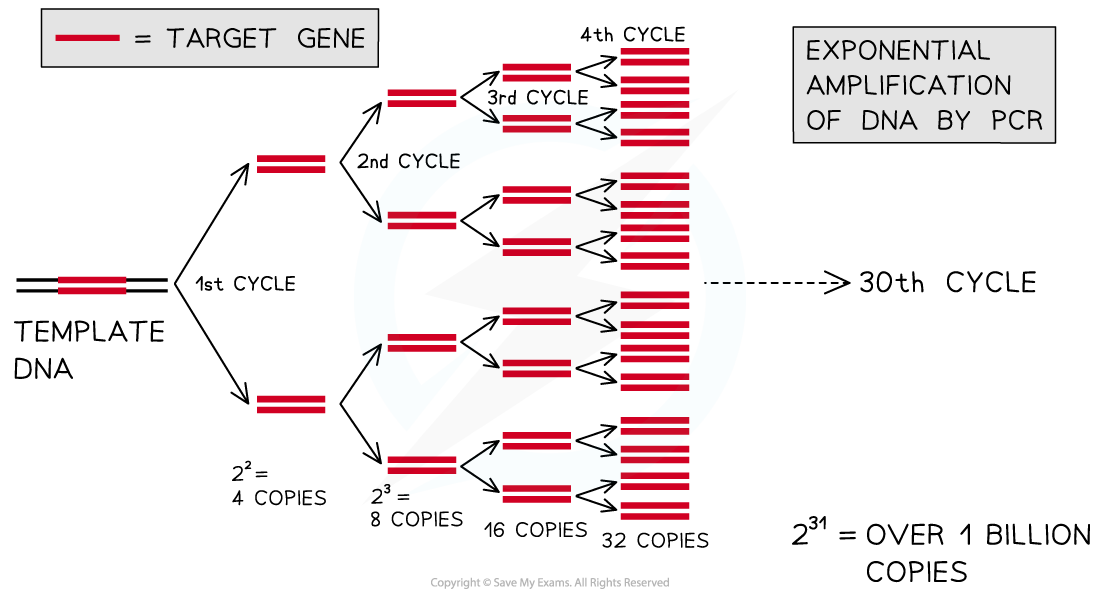Gel Electrophoresis
Gel electrophoresis is used to separate proteins or fragments of DNA according to size
- Gel electrophoresis is a technique used widely in the analysis of DNA, RNA, and proteins
- During electrophoresis, the molecules are separated with an electric current according to their size or mass and their net (overall) charge
- This separation occurs because of:
- The electrical charge molecules carry:
- Positively charged molecules will move towards the cathode (negative pole), whereas negatively charged molecules will move towards the anode (positive pole) e.g. DNA is negatively charged due to the phosphate groups and thus, when placed in an electric current, the molecules move towards the anode
- The different sizes of the molecules:
- Different sized molecules move through the gel (agarose for DNA and polyacrylamide for proteins) at different rates. The tiny pores in the gel result in smaller molecules moving quickly, whereas larger molecules move slowly
- The type of gel:
- Different gels have different sized pores that affect the speed at which the molecules can move through the gel
- The electrical charge molecules carry:
DNA separation
- DNA can be collected from almost anywhere on the body, e.g. the root of a hair or saliva from a cup. After collection, DNA must be prepared for gel electrophoresis so that the DNA can be sequenced or analysed for genetic profiling (fingerprinting)
- To prepare the fragments, scientists must first increase (amplify) the number of DNA molecules by the Polymerase Chain Reaction (PCR)
- Then restriction (DNA-cutting) enzymes are used to chop the DNA into fragments
Method
- To separate the DNA fragments in gel electrophoresis:
- Create an agarose gel plate in a tank. Wells (a series of small rectangular holes) are cut into the gel at one end
- Submerge the gel in an electrolyte solution (a salt solution that conducts electricity) in the tank
- Load (insert) the DNA fragments into the wells using a micropipette
- Apply an electrical current to the tank. The negative electrode must be connected to the end of the plate with the wells as the DNA fragments will then move towards the anode (positive pole) due to the attraction between the negatively charged phosphates of DNA and the anode
- DNA fragments with a smaller mass (i.e. shorter DNA fragments) will move faster and further from the wells than the larger fragments
- The fragments are not visible so must be transferred onto absorbent paper or nitrocellulose which is then heated to separate the two DNA strands
- Probes are then added to develop a visual output, either:
- A radioactive label (e.g. a phosphorus isotope), which causes the probes to emit radiation that makes the X-ray film go dark, creating a pattern of dark bands
- A fluorescent stain or dye (e.g. ethidium bromide), which fluoresces (shines) when exposed to ultraviolet (UV) light, creating a pattern of coloured bands


The process of electrophoresis
Exam Tip
Remember gel electrophoresis is the separation of molecules according to their size and charge (negatively charged DNA molecules move to the positive pole). Examiners like to ask questions about gel electrophoresis, so make sure you understand each of the different steps in the process.
Polymerase Chain Reaction (PCR)
PCR can be used to amplify small amounts of DNA
- Polymerase Chain Reaction (PCR) is a common molecular biology technique used in most applications of gene technology
- For example, it is used in DNA profiling (e.g. identification of criminals and determining paternity) or genetic engineering
- In the COVID-19 pandemic, PCR has been used in routine diagnostic testing to amplify small amounts of viral RNA
- It can be described as the in vitro method of DNA amplification
- It is used to produce large quantities of specific fragments of DNA or RNA from very small quantities (even just one molecule of DNA or RNA)
- Using PCR, scientists can produce billions of identical copies of the DNA or RNA samples within a few hours, these can then be used for analysis
The requirements of PCR
- Each PCR reaction requires:
- The target DNA or RNA that is being amplified
- It's important that the whole genome is not required to be copied - only specific sections that vary from one individual to another
- These sections are identified by adding a primer sequence that binds to them
- DNA polymerase - the enzyme used to build the new DNA or RNA strand. The most commonly used polymerase is Taq polymerase as it comes from a thermophilic bacterium Thermus aquaticus
- This means it does not denature at the high temperature involved during the first stage of the PCR reaction
- Free nucleotides - used in the construction of the DNA or RNA strands
- Buffer solution - to provide the optimum pH for the reactions to occur in
The key stages of PCR
- The PCR process involves three key stages per cycle
- In each cycle the DNA is doubled (so in a standard run of 20 cycles a million DNA molecules are produced)
- The PCR process occurs in a piece of specialist equipment called a thermal cycler, which automatically provides the optimal temperature for each stage and controls the length of time spent at each stage
- The three stages are:
- Denaturation – the double-stranded DNA is heated to 95°C which breaks the hydrogen bonds that bond the two DNA strands together
- Annealing – the temperature is decreased to between 50 - 60°C so that primers can anneal to the ends of the single strands of DNA
- Elongation / Extension – the temperature is increased to 72°C for at least a minute, as this is the optimum temperature for Taq polymerase to build the complementary strands of DNA to produce the new identical double-stranded DNA molecules
- Each whole cycle takes a few minutes, so 30 cycles can take just a few hours and can generate 231 (over 1 billion) copies of a gene from a single DNA molecule, by exponential amplification

Target DNA sequences can be copied exponentially by PCR to generate billions of copies in a short time
Exam Tip
You don't need to know the detail of the three stages and the temperatures the reactions occur at during the different stages. However, you must know why the Taq polymerase is used in PCR (from Topic 2.6.3). The main learning point is that PCR can be used to amplify very small amounts of DNA into large numbers of molecules for analysis.
